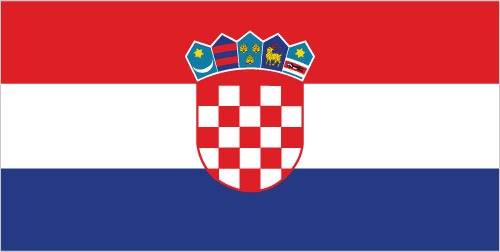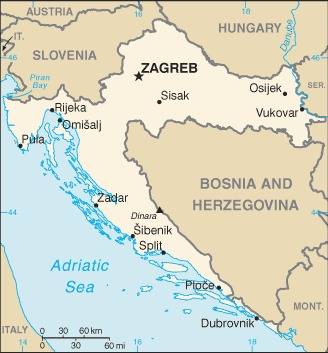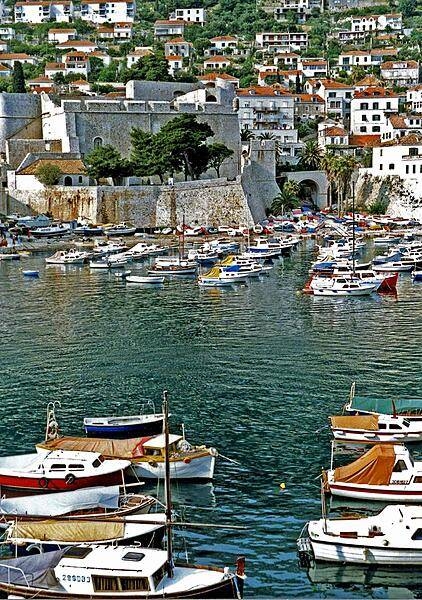61 Croatia

Three equal horizontal bands of red (top), white, and blue – the Pan-Slav colors – superimposed by the Croatian coat of arms. The coat of arms consists of one main shield (a checkerboard of 13 red and 12 silver (white) fields) surmounted by five smaller shields that form a crown over the main shield. The five small shields represent five historic regions (from left to right): Croatia, Dubrovnik, Dalmatia, Istria, and Slavonia.
Flag courtesy of the CIA World Factbook

Map courtesy of the CIA World Factbook

The inner harbor of Dubrovnik.
Photo courtesy of the CIA World Factbook
Government
According to Britannica, on December 22, 1990, the constitution of the Republic of Croatia was promulgated. In addition to such classic civil rights as freedom of speech, religion, information, and association, the equality of nationalities is guaranteed in a number of constitutional articles. Cultural autonomy, along with the right to use one’s own language and script (the latter specifically intended for the Serb minority), is also guaranteed.
The 1990 constitution changed the structure of the Sabor (parliament) from a tricameral body under the Yugoslav system to a bicameral body consisting of the House of Representatives (lower house) and the House of Districts (upper house). Constitutional amendments in 2001 abolished the upper house, thereby rendering the Sabor a unicameral body. Members are elected from party lists every four years. In addition, a small percentage of seats are reserved for national minorities and for representatives of Croats living outside the country.
The president of the republic is elected directly by popular vote for a period of five years and is limited to two terms. The 1990 constitution originally granted the president very broad powers; this “superpresident” appointed and could dismiss the prime minister, who was nominally responsible to both the parliament and the president but was actually directly dependent on the president. Constitutional amendments in 2000 reduced the importance of the president, who thenceforth served solely as head of state, and increased the power of the parliament and of the prime minister, who assumed the role of head of government. The president continues to nominate the prime minister, but the Sabor must confirm the appointment. In addition, the prime minister is typically the head of the leading party in the Sabor.
Below the national level, Croatia is divided into 20 administrative districts called županije (counties). One city, Zagreb, has an administrative status equivalent to that of the counties. Within the županije are hundreds of općine (municipalities).
The Supreme Court, county courts, and municipal courts constitute the three-tiered judicial system. The Supreme Court is the highest legal authority in all matters but constitutional questions, which are decided by the Constitutional Court. Justices on the Supreme Court are appointed by a judicial council, which is elected by the Sabor. The independence of the judiciary has been questioned, largely because many of the judges who were politically appointed in the 1990s remained in office well into the 21st century. However, there have been significant reforms to the judiciary, largely under EU pressure.
Croatian Civil Aviation Agency
Croatian Civil Aviation Agency was founded by an Act on Amendments to the Air Traffic Act, adopted by Croatian Parliament on its session from 20th of April 2007 (Official Gazette 46/2007). Founder of the Agency is the Republic of Croatia, with Government of the Republic of Croatia holding the founding rights pursuant to the afore-mentioned Act. Agency is independent and non-profit legal entity which conducts activities in the interest of the Republic of Croatia within the scope defined in the Air Traffic Act and Statute of the Agency. The Agency reports to the Government of the Republic of Croatia by submitting Annual Work Reports. Agency began with its operation on 9th of March 2009. Activities of the Agency include air traffic safety related tasks, especially certification, oversight and supervision with the objective of ensuring continuing compliance with the requirements of the air transportation and other air traffic related activities, keeping of all relevant registers and records, and any other task as defined under the Air Traffic Act. Activities of the Agency fall under the competence of the Ministry of the Maritime Affairs, Traffic and Infrastructure. Pursuant to the provisions of the Air Traffic Act and the Agency’s Statute, Agency is governed by the Agency Board consisting of five members. The Board is appointed by the Government upon the proposal of the Minister. The Agency Board has no executive or regulatory authority and cannot impose measures which fall under the jurisdiction of the Agency.
Airspace
SkyVector – Google Maps – ADS-B Exchange
ICAO countries publish an Aeronautical Information Publication (AIP). This document is divided into three parts: General (GEN), En Route (ENR) and Aerodromes (AD). ENR 1.4 details the types of airspace classes they chose to adopt from classes A through G.
Croatia Control
Croatia Control Ltd. is a company owned by the Republic of Croatia, which provides air navigation services.
Drone Regulations
Flight Operations and Education
Advanced Air Mobility (AAM) Regulations & Policies
EASA – Urban Air Mobility (UAM)
Bilateral agreements facilitate the reciprocal airworthiness certification of civil aeronautical products imported/exported between two signatory countries. A Bilateral Airworthiness Agreement (BAA) or Bilateral Aviation Safety Agreement (BASA) with Implementation Procedures for Airworthiness (IPA) provides for airworthiness technical cooperation between the FAA and its counterpart civil aviation authorities.
Reciprocal acceptance of aviation safety-related approvals and services with the European Union Aviation Safety Agency (EASA) and Member States of the European Union are primarily governed by the U.S. – European Union Safety Agreement.
Advanced Air Mobility (AAM) News
None found by the author.
However, should you, the reader, happen to stumble across something to the contrary, please email the author at FISHE5CA@erau.edu and you may be mentioned in the ACKNOWLEDGEMENTS section of this book by way of thanks for contributing to this free eBook!
Short Essay Questions
Scenario-Based Question
You have been hired by a Drone Startup Company. Your boss has immediately assigned this job to you.
They need you to prepare a one-page memo detailing the legalities of using a drone over the harbor in Dubrovnik, pictured above.
They need you to mention any national laws and local ordinances.
They specifically want to know what airspace (insert pictures) you will be operating in and whether or not you need an airspace authorization.
Does it matter whether or not you are a citizen of the country?
Lastly, there is a bonus for you if, as you scroll through this chapter, you find any typos or broken links!
Short Essay Questions
- What are the drone categories?
- How is registration addressed?
- How is remote ID addressed?
- What are the model aircraft rules?
- What are the commercial drone rules?
- Are there waivers or exemptions to the rules? If so, for what?
- Would you share a link to an interactive airspace map?
- How is BVLOS addressed?
- How can you fly drones at night?
- How can you fly drones over people?
- Where do you find drone NOTAMs?
- What are the rules for drone maintenance?
- What are the rules for an SMS program?
- What are some unique rules not mentioned above?
- What are the C-UAS rules?
- What are the AAM rules?

